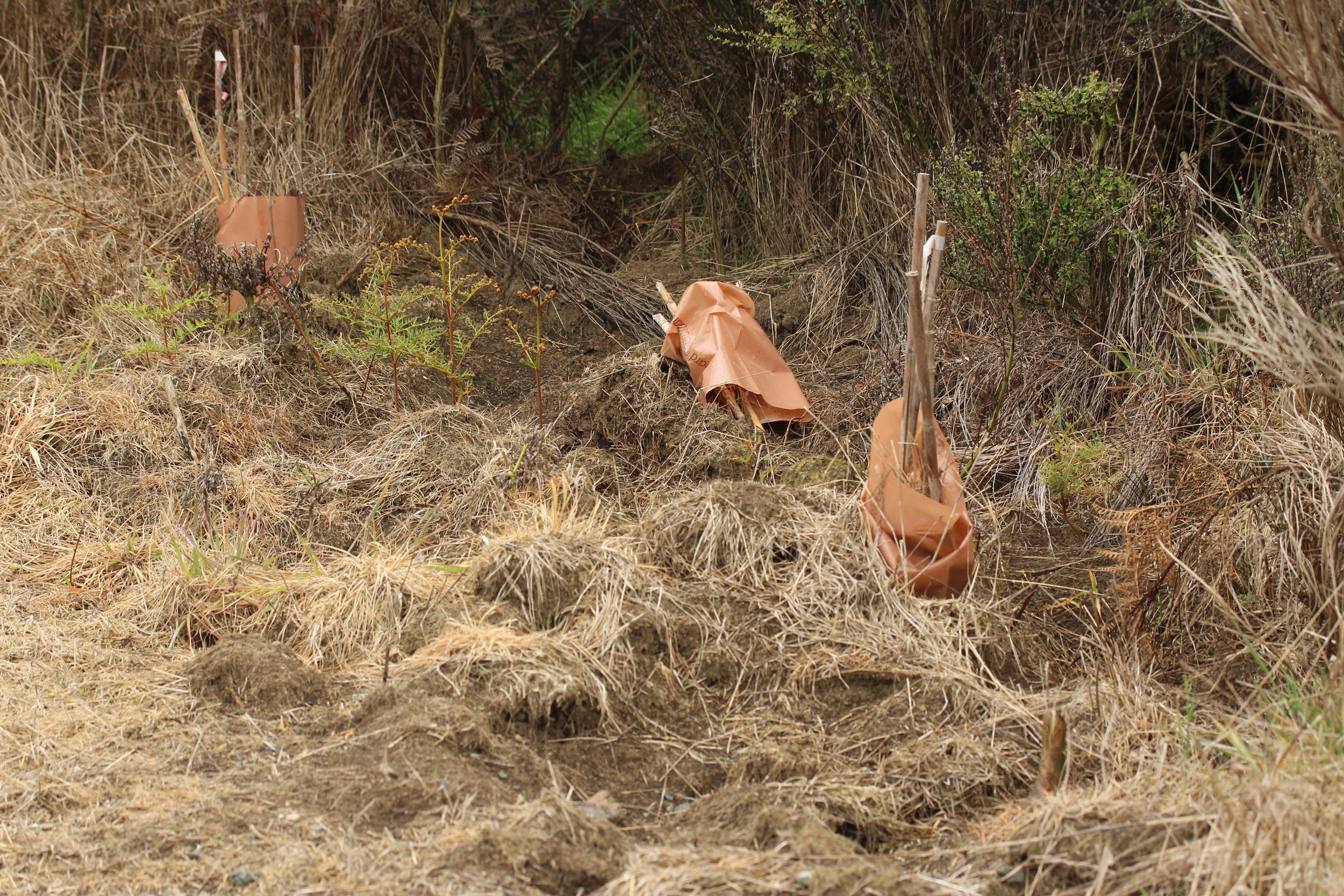Controlling feral pigs at Te Kōawa
Damage caused by feral pigs at Te Kōawa
One of the most pressing threats at Te Kōawa Tūroa o Takitimu is the damage caused by feral pigs. Feral pigs are abundant in the valley, and although numbers can be reduced via hunting, reinvasion will always occur from the Takitimu maunga and neighbouring forestry and farming blocks.
Anecdotal evidence has shown feral pigs have significantly increased in numbers in recent years in Jericho Valley, as well as neighbouring sites. Te Kōawa is prime habitat for feral pigs, with a year-round water supply, adequate food, and good cover provided by regenerating mānuka, bracken fern, broom, gorse and other scrub.
Native seedlings coming up under the shelter of mānuka. These are vulnerable from pig rooting
Feral pigs can impact biodiversity in a number of ways. One of the objectives of our Te Kōawa Mahinga Kai Restoration Plan is to facilitate natural regeneration of the site. While the natural regeneration on the valley floor has been pretty impressive in recent years, rooting from feral pigs is causing significant damage and disturbance. Rooting is where pigs dig in the ground with their snouts to search for food, and large areas of ground are overturned.
Pig rooting impedes natural regeneration by disturbing native seedlings and the roots of established plants, and also damages/kills trees that have been planted as part of our native replanting programme.
Damage to native plantings caused by feral pigs
Feral pigs can impact on native biodiversity in other ways too. They are omnivorous and opportunistic feeders. They eat native vegetation including grasses, fruits, and the roots of plants, with a favourite being the root and base of aruhe/bracken fern. At Te Kōawa feral pigs dig up and eat the roots of Taramea/speargrass - a taonga species. Pigs also predate on and destroy the eggs and young of ground-nesting or flightless manu, consume native invertebrates such as earthworms and snails, and other animals such as frogs and lizards, and even native tuna/eels.
At Te Kōawa our approach to control feral pigs is to exclude them from key areas of the site using electric fences. This approach is being used for the following reasons:
It is difficult to reduce and sustain feral pig populations at low levels using hunting and trapping alone. This is due to continual reinvasion from neighbouring areas and other parts of Te Kōawa which have very high densities.
Te Kōawa has existing fencelines from its farming days that can be electrified, thus making this option more cost effective;
Electric fencing allows the site to be partitioned, so that pigs can be eliminated from smaller areas before moving onto the next area. In this way, the same ground doesn’t need to be continually revisited.
Elimination of pigs within the fenced areas is required to adequately protect our native plantings, and to protect regenerating areas so the native species can establish. Without this protection, plantings and native seedlings are at risk of being disturbed, even when pigs are at low numbers.
Te Kōawa is divided into zones based on landform, habitat and property layout. Zone B encompasses the area closest to the main entrance, and includes the lodge and the ponds created by the Jericho Stream high water diversion. This area is the focus for the first stage of the restoration project, and will see more intensive trapping and pest control, and native planting.
An electric fence will go around the entire perimeter of Zone B, and will protect about 80 ha, including some of the more intact wetlands and native forest regeneration areas in the western portion of Te Kōawa. It also encompasses the lodge area and will protect the tree planting areas along the roadside and near the lodge.
This area of regenerating bush and wetlands will be protected by the Zone B Pig Exclusion Fence
Much of this pig exclusion fence is using existing fencelines. Four kilometres of old stock fencing has had an electric outrigger wire fitted, and 2.5 kilometres of new fence has been installed as part of this mahi to complete the pig exclusion area.
Clearing the old fence of broom, gorse, bracken and scrub was a big job in itself, before the fencing mahi could start. Great progress has been made over the last month, helped along by the glorious weather the deep south has had this summer.
The pig exclusion fence around Zone B should be finished by Easter, after which we will start to remove all feral pigs from within the fenced area over the following few months. This will be done using professional ground and aerial hunters using thermal imaging technology, as well as live capture pig traps.
We acknowledge that pigs, while a pest, are also a good source of kai for many in the South. The ultimate goal is to exclude pigs from large areas of Te Kōawa, however there will still be parts of the site that will remain unfenced, which pigs will still be able to access. This includes much of the back half of the valley floor and land adjacent to Redcliff Creek, as well as the conservation estate.
Once the pig exclusion fence in Zone B is completed and pigs are eliminated from this zone, we will shift the focus to the terrace in the Southwest corner of the site where we are establishing a Carbon Forest in partnership with Meridian Energy. Part of the Carbon Forest will be planted in pinus attenuata which will be transitioned to native forest over approximately 50 years. The remaining area will be planted with native tree species. An electric pig exclusion fence will be established around this terrace on existing fencelines to protect the new seedlings.
A large boar captured in the pig trap in 2021. Photo: Dave Crouchley
The pig trap is baited with a grain feeder. Photo: Dave Crouchley
Feral pigs in the pig trap at Te Kōawa captured on our trail camera.











